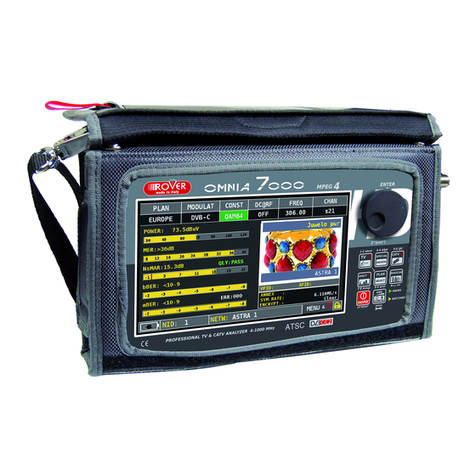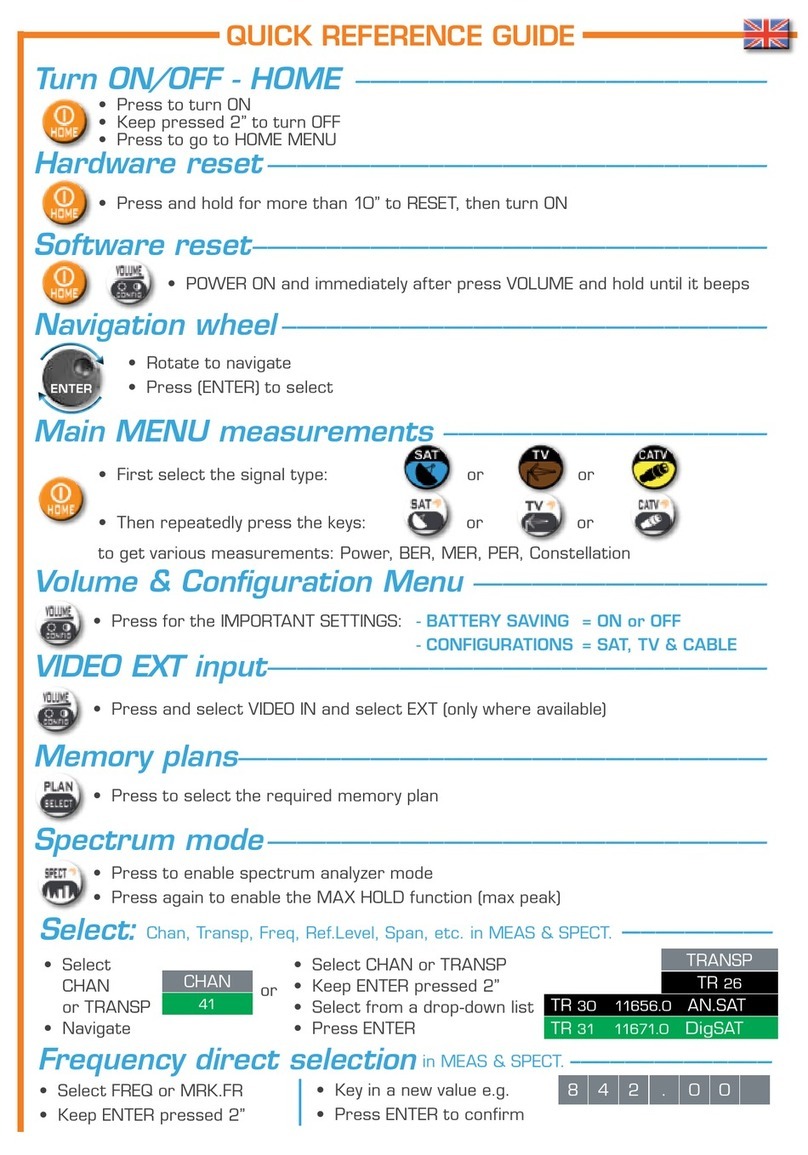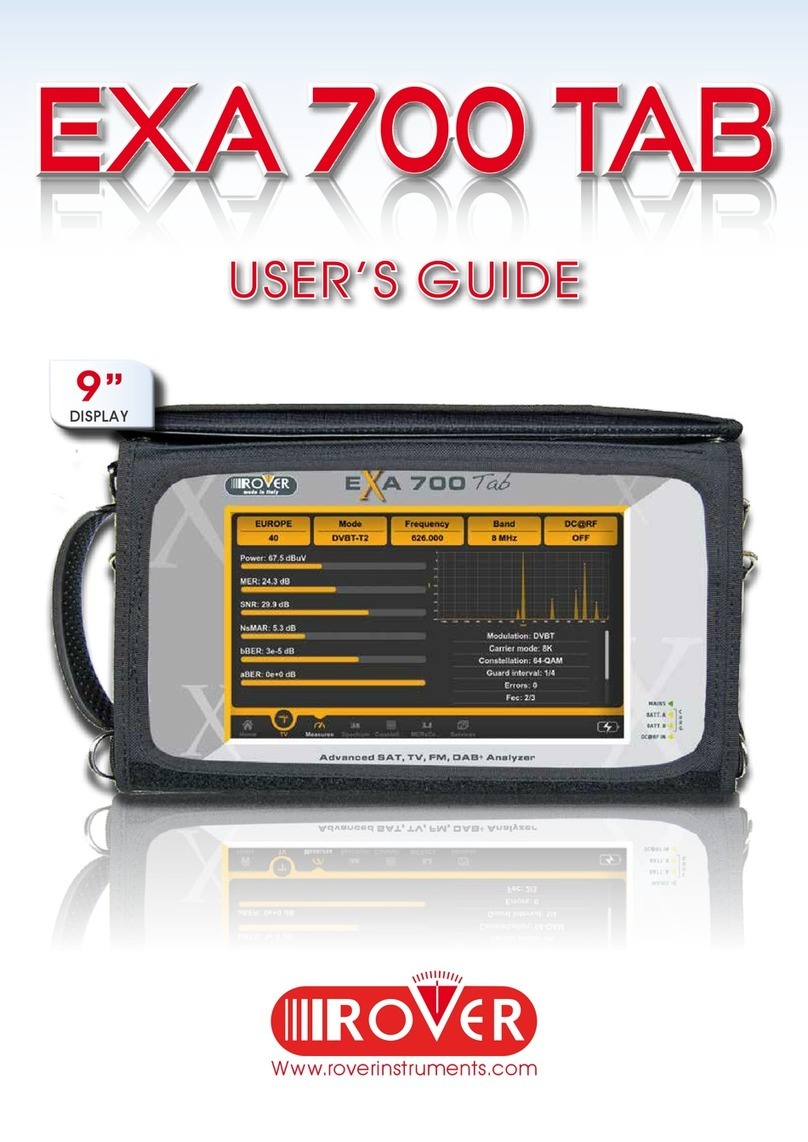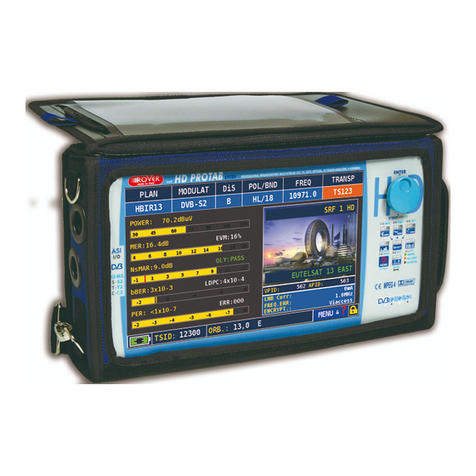S2
USER MANUAL
4
9.2 MANUALLY TUNING THE TRANSPONDER (BY KNOWING ALL THE DISTINCTIVE
PARAMETERS)..........................................................................................................18
9.3 NAVIGATE THE SOLE TRASPONDERS INCLUDED IN A USER DEFINED MEMORY
PLAN..........................................................................................................................20
~___ SELECT THE DESIRED TRANSPONDER...............................................................20
~___ MANUALLY MODIFY THE FREQUENCY VALUE....................................................21
~___ MODIFY THE TRANSPONDER MEMORY PLAN TO BE NAVIGATED....................21
10 _PERFORMING MEASURES: MEAS.....................................................................................22
10.1 ANALOGUE TRANSPONDER....................................................................................22
~___ LEVEL MEASUREMENT.........................................................................................22
~___ SPECTRUM ANALYSIS...........................................................................................22
10.2 DIGITAL TRANSPONDER..........................................................................................23
~___ THE TRANSPONDER TUNED IS INCLUDED IN A PRE-MEMORIZED SATELLITE
OR THE TRANSPONDERWAS MANUALLY TUNED..............................................23
~___ THE TRANSPONDER IS INCLUDED IN A USER-DEFINED TRANSPONDER
MEMORY PLAN......................................................................................................24
{CHANNEL POWER MEASUREMENT..................................................................................24
{NOISE MARGIN, QUALITY TEST, MER E EVM MEASUREMENTS.....................................24
{BER MEASUREMENTS BEFORE AND AFTER VITERBI CORRECTION .............................25
{FEC AND BOUQUET MAIN DATA.......................................................................................25
{SERVICE LIST OF THE CURRENT BOUQUET ...................................................................26
{SPECTRUM ANALYSIS....................................................................................................... 26
11 _SPECTRUM ANALYZER MODE...........................................................................................27
11.1 CHANGE THE TRANSPONDER.................................................................................27
11.2 CHANGE THE MARKER POSITION (FREQUENCY)..................................................27
11.3 EDITING THE SIGNAL LEVEL END OF SCALE.........................................................28
11.4 CHANGE SPAN..........................................................................................................28
11.5 ACTIVATE THE MAX HOLD FUNCTION....................................................................28
12 _AUTOMATICSTORAGE OF TRANSPONDERS MEASURES (DATA LOGGER)...................29
12.1 AUTOMATICALLY STORE TRANSPONDER MEASURES (AUTO MEAS&STORE)...29
12.2 DELETE A MEMORY PLAN........................................................................................30
13 _CREATING AUSERDEFINED TRANSPONDERMEMORY PLAN.......................................31
13.1 MANUALLY CREATE A USER DEFINED MEMORY PLAN: MEMORY.......................31
~___ CREATE A BRAND NEW MEMORY PLAN..............................................................31
~___ ADD A NEW TRANSPONDER TO AN EXISTING MEMORY PLAN.........................32
13.2 ADD A SELECTED TRASPONDER TO A EXISTING USER DEFINED MEMORY PLAN
32
13.3 DELETE A USER DEFINED MEMORY PLAN.............................................................33
~___ DELETE A USER DEFINED MEMORY PLAN..........................................................33
~___ DELETE A LOGGER FILE (LOGGER MEMORY PLAN) ..........................................33
14 _TECHNICAL SPECIFICATIONS...........................................................................................35
SERVICE NOTES AND GUARANTEE REGULATIONS (UE AND EXTRA UE)................. 37
FAULT IDENTIFICATION FORM........................................................................................ 39
MANTAINING THE METER................................................................................................ 40
DISPOSAL OF ELECTRONIC EQUIPMENT
..................................................................... 41




































